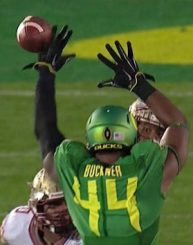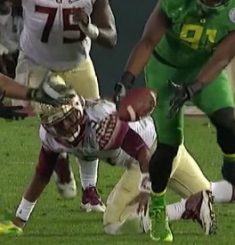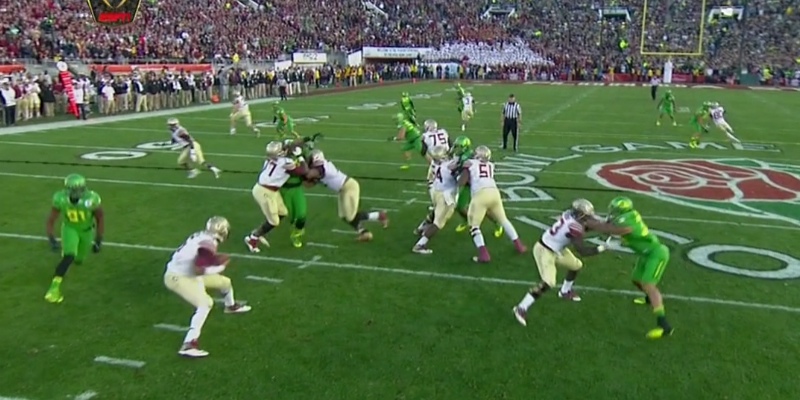(Converting from a 3-4 defense to 4-3 front is a topic that Oregon fans were interested in discussing–especially when Coach Mike Morris gave his perspective on it last week. He saw many posts on six different sites and message boards that contained some “points he disagreed with.” The Grizzled Ol’ Coach is not one to debate online with other readers, thus below is his response to the “________” comments he read. (I deleted Mike’s colorful language out) Again…these are HIS opinions, but I think many of us will learn quite a bit. Enjoy! Charles Fischer
After reading the comments to my article last week about Oregon’s possible switch from a 3-4 to a 4-3 defense, it seems I’ve got more explaining to do. There seem to be some myths out there that need busting.
Myth: “The 4-3 is more ‘robust’/’physical’ than the 3-4 because it has 4 down-linemen instead of 3.”
Actually the 3-4 had more defenders – and more BIG defenders — on the line of scrimmage than the traditional 4-3. This season, except for obvious passing situations, the Ducks used at least a 4-3 alignment. In their most used defensive scheme, the Ducks had 5 defenders (the 3 defensive linemen and both OLBs) on the line of scrimmage (a “50” front). Until fairly recently, the 3-4 defensive scheme was usually called the “50” or 5-2 defense.
Myth: “It would be very difficult to switch from the 3-4 to the 4-3.”
One responder described that change as “monumental.” It would be difficult to switch to the 3-4 from the 4-3. Many different and difficult techniques would have to be learned. But in the 4-3 those difficult techniques would no longer be required. Every defensive player would have an easier time executing the 4-3.
Myth: “It takes more defensive linemen to be able to use the 4-3 defensive system.”
Actually it requires fewer big defensive linemen to run the 4-3. In the 3-4, both DEs have to be at least 270 pounds and the NT (nose tackle) at least 290, to be consistently successful. Including 2nd-stringers, that’s 6 BIG dudes. In the 4-3, only 4 (2-strings of DTs) would be necessary, and no one would have to top 290.

Buckner deflection
Any defensive lineman who could consistently execute the 4-technique (“controlling” the inside shoulder of an offensive tackle), used most of the time by Oregon’s 3-4 DEs (Armstead, Buckner, etc.) would be able to more easily execute the 3 and 1 techniques utilized in the 4-3 scheme. In nickel situations, when Armstead and/or Buckner were allowed to use the 3 technique (attacking and penetrating through the outside shoulder of the OG), I could see them happily salivating through their facemasks.
The NTs would also be excited about switching from the 0-technique (going straight into and controlling the center), and, instead, getting to attack a gap. Balducci and Maloata could each lose about 20 pounds and be more effective pass rushers and football players.
It takes more LBs – guys to play in space – to run the 3-4 defense, and that’s the hardest thing for high school players to learn how to do well in college. In the 4-3, a high school safety, someone who’s earned his scholarship by his ability to play in space, can be the OLB.
Myth: “4-3 defensive ends have to be big guys.”
Nope. They have to be fast guys, “speed-rushers.” Remember Kenny Rowe and Nick Reed? If they happen to be big (especially tall), so much the better. Prevot and French are big for 4-3 DEs, but, more importantly, they’re very fast, excellent outside pass rushers. If the Ducks switched to the 4-3, Prevot and French would be the happiest guys on the team. Heck, ALL the defensive linemen would be VERY happy. That seems like kind of a good thing.
Think of Tony Washington‘s big plays. Where were they made? What was he doing? Remember any made out in space? Tony W. wasted a lot of time out in space. In my original article I mentioned that really good 4-3 DEs were the easiest high school football players to find. But then having to convert them to OLBs is extremely difficult.
Myth: “Oregon will never have the ‘SEC-type’ of defensive linemen to beat ‘smash-mouth,’ physical offenses.”

Torrodney Prevot
How ’bout having the best defensive lineman in the country (DeForest Buckner)? The best freshman defensive lineman in the country (Canton Kaumatule)? Two early-round-NFL-draft-worthy DEs (Torrodney Prevot and Christian French)? For those of you who doubt that last one, remember Dion Jordan and compare him to Prevot and French.
And, almost as important as those starters, Oregon now has enough quality depth of defensive linemen to physically compete with anyone. Next season there will be 3rd string defensive linemen who could have started for past Duck teams.
Myth: “The 4-3 requires an amazing stud at middle linebacker.”
Actually the ILB (Inside Linebacker) responsibilities won’t change much. Nowadays the 4-3 is actually a 4-2. One ILB has the A-gap, and the other ILB takes the B-gap, depending how the DTs align. The days of the “pro 4-3” (essentially a 6-1), and “college 4-3” (a MLB and OLBs over the OTs) (the days of the classic, prototypical MLB) are over. The 4-3 isn’t a magic cure for poor ILB play. Hopefully, experience and improved defensive line play helps the Duck ILBs to significantly improve.
Myth: “The 4-3 alignment is too predictable.”

A ground view of Oregon’s defense…
There’s an “over” front, with the 3-technique DT to the tight end or wide side, and an “under” front, with the 3-tech. opposite the TE or to the short side of the field. The DEs don’t “flip-flop” (change sides depending on the call or formation). (One of my pet peeves is when some of you refer to a “SDE” or a “WDE.”)
But I’d MUCH prefer being predictable than having confused defensive players. Far too many times recently the Ducks have blown gap-fits (left a gap with no defender there). The fast tempo of today’s offenses makes the simplicity of defensive calls essential. Because the OLB in a 4-3 can be a safety-type, the defense doesn’t need to sub to get into a “nickel” (5 DBs) pass defense.
Myth: “Certain offensive schemes are more effective against certain defensive schemes.”
I talked about this misconception in the first article. A defensive scheme is only as good as the players are that are executing it. Please remember, “It’s not WHAT you do, but HOW you do it.” “It’s about the Jimmy’s and Joe’s (the players you have), not the X’s and O’s.” When Derek Mason was the defensive coordinator at Stanford, he was considered a genius. Last year, as the head coach at Vanderbilt, not so much. Mason’s defense was continually destroyed. How’d Stanford’s incredible scheme to stop the Oregon spread do last year, when its players weren’t as good?
All a defensive coordinator can hope to do is maximize the talents of his players, and help them to avoid making stupid mistakes. Recruit really good players and then put them in a system that allows their coaches to teach them to play to the best of their abilities.
That’s all for now. But if you respond with more of your football truisms, I’ll gladly debunk them for the myths they actually are.
Coach Mike Morris (Grizzled Ol’ Coach)
Oregon Football Analyst for CFF Network/FishDuck.com
Pleasant Hill, Oregon
Top Photo from Video
(Charles Fischer will be giving a Video Presentation that is a composite of analyses done by GOC and other coaches on the FishDuck.com staff on Wednesday, February 25th at 5:30 PM at The Cooler Pub and Restaurant in Eugene. Assistant Head Coach Steve Greatwood is the main speaker and then we will look closely at the great plays of the Football Playoffs, and the strategy behind what made one play work so well against the Ducks in the NC Game. This presentation is given for the public and the Eugene/Springfield Oregon Club and is available for other clubs, civic groups, and nonprofits by Charles. Join us!)
Coach Mike Morris spent 30 years coaching at seven different high schools throughout Southern California. He coached many players who went on to Pac-12 programs including Oregon, such as Saladin McCullough. He is a writer, Football analyst and a good friend of the Principal of the site.

